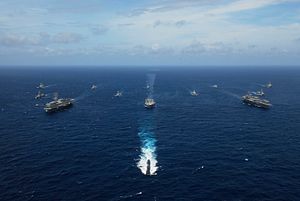On Friday, Japanese Prime Minister Shinzo Abe will begin his three day visit to India, where he will meet his counterpart, Narendra Modi.
This will be the ninth time for Japan and India to hold annual summit-level talks at the prime ministerial level. Relations between the two countries began to pick up during Abe’s previous term, and he was the chief guest at India’s Republic Day celebrations in January 2014 during the tenure of former Indian Prime Minister Manmohan Singh, a first for any Japanese premier. That is an indicator of the fact that closer ties with Japan enjoys bipartisan support in India.
During his visit, apart from the regular meetings he will hold, Abe is also expected to visit Varanasi, which is also the Lok Sabha constituency of Indian Prime Minister Narendra Modi. A partnership city arrangement was signed between Varanasi and Kyoto during Modi’s visit to Japan last year.
What is the significance of Abe’s visit? There are five points to keep in mind that provide important context for both what is likely to occur during this visit as well as the backdrop against which it is occurring.
First, Abe’s visit will sustain the momentum already built up in bilateral ties. Japan was the first country Modi visited outside the Indian subcontinent after he took office in May last year. This return visit by Abe will be a boost in the other direction. During Modi’s Japan visit, the relations were upgraded to a “Special Strategic and Global Partnership.”
Second, economically, this visit by Abe is expected to see the finalization of the deal for Japan to supply its Shinkansen (bullet train) technology to India, beginning with the Mumbai-Ahmedabad bullet train corridor in western India.
Third, turning to the security realm, the trip comes against the backdrop of a Japan that is looking to enhance its contributions to regional and global security. In that vein, during Abe’s visit, a deal may also be reached for India to buy the Japanese-made US-2 maritime reconnaissance aircraft, marking a first for Japan, which has traditionally been reticent to supply Japanese-made military hardware to other countries. It is also likely that a technology-sharing agreement for this aircraft will be concluded.
Fourth, Abe’s India visit will also strengthen security ties at a time when broader convergences are occurring between India and Japan as well as other countries like the United States and Australia. After years of not being invited by New Delhi to participate in the India-U.S. Malabar naval exercises for fear of alienating Beijing, Japan was invited this year. The exercises were held in October in the Bay of Bengal. India, Japan, and the United States have also been holding a trilateral dialogue among themselves which started in December 2011. Although India is not an ally of the United States, during the visit of U.S. President Barack Obama to India as the chief guest during the Republic Day celebrations in January this year, the two countries issued a joint statement affirming “the importance of safeguarding maritime security and ensuring freedom of navigation and over flight throughout the region, especially in the South China Sea.” In the past, India has been wary of being drawn into the South China Sea dispute, but this statement marked a break from the past.
Fifth, India is one of four outside bases Japan has selected for its specialized intelligence gathering unit to collect information on terrorist activities (the other three are Jordan, Egypt, and Indonesia). Terrorism has been a growing concern for Tokyo. Although there have been no terrorist attacks on Japanese soil, its nationals Kenji Goto and Haruna Yukawa were beheaded by the Islamic State this year, while an attack on a natural gas facility in Algeria in January 2013 killed seven Japanese citizens. In March 2015, a terrorist attack on a museum in Tunisia led to three Japanese deaths. In addition to helping save Japanese lives at home and abroad, intelligence will boost Japanese security as it prepares for the G-7 Summit in May next year at Ise-Shima in Mie Prefecture and the Tokyo Olympics in 2020.
This is not to say that there aren’t challenges for Japan-India relations. For example, the two prime ministers will have to do some heavy lifting in order to boost trade levels. Even though a Comprehensive Economic Partnership Agreement (CEPA) was signed between the two countries and implemented from August 2011, bilateral trade stood at just $16.31 billion during the fiscal year 2013-14, which represents just around 1 percent of Japan’s total foreign trade. In addition, it remains to be seen if a civilian nuclear deal between Japan and India can be finalized during this visit. There are still many details to be worked out and Abe is likely to face huge domestic opposition back home if he does sign a civilian nuclear pact with India.
Both Abe in Japan and Modi in India lead majority governments and hence are not prone to the pulls and pressures of coalition politics. All the more reason, then, for both of them to seize the initiative and take the bilateral relations to a new high.
Dr. Rupakjyoti Borah is currently a Visiting Scholar based at the National Chung Hsing University, Taiwan. He was previously a Visiting Research Fellow at the Japan Institute of International Affairs (JIIA), Tokyo. The views expressed are his own.

































